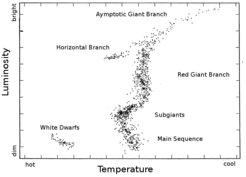The life-cycle of stars
Stars are born in massive clouds of gas and dust. Star forming regions are triggered by disturbances to these clouds (say by a nearby supernova) which initiate gravitational collapse. The chemical composition, mass and angular momentum of the gas and dust in the collapsing region are key ingredients that determine the evolution of the star that eventually forms.

As more and more material is drawn into the centre of the collapsing region a proto-star develops. Proto-stars above a critical mass (0.075 Mʘ, where Mʘ is the mass of the Sun) eventually become hot enough to initiate hydrogen fusion in their cores: the key requirement for it to attain the status of a true star.
Figure 1 is an example of a Hertzsprung-Russell (HR) diagram for low to intermediate (0.075 Mʘ - 5ʘ) mass stars; one of the most important tools in stellar astronomy. The two scientists, whom the diagram is named after, discovered that by plotting the brightness of stars against their surface temperature an evolutionary sequence could be determined. The moment the star is powered by core hydrogen burning the star is said to have joined the main sequence. It is the first of several key phases of the stellar life-cycle. The main sequence is a quiescent stage of evolution, marked by a gradual increase in surface temperature and luminosity. It is the longest phase of evolution and as the name suggests where a majority of stars are found in the HR-diagram.
Once the energy supply in the core is exhausted and all the central hydrogen converted into inert 4He, stars enter a new phase of evolution. Stars with mass above approximately 0.25 Mʘ 'turn off' the main sequence and develop into subgiants. Stars below this mass fail to progress to more advanced burning stages and eventually become white dwarfs. During the subgiant phase, the star's structure begins to change significantly - hydrogen burning shifts to a shell around the core, the envelope swells up and the surface temperature begins to drop. It becomes a true giant once the shell burning impacts upon the surface luminosity. As the luminosity steadily increases, the star ascends the red giant branch (RGB). During this phase the hydrogen-burning shell adds processed (helium-rich) material to the core.
Eventually the central temperatures reach upwards of 100 MK and the conditions allow for the burning of helium in the core via the triple-alpha process. How helium ignition occurs will depend on the mass of the star. Low-mass stars (M > 2.25 Mʘ) are characterised by a degenerate helium core. This state of matter is governed by the principles of quantum mechanics and ignition under these conditions occurs via a violent flash. In more massive stars (with non-degenerate cores), a more gentle transition into central helium burning occurs.
The core-helium burning phase of evolution (labelled as the horizontal branch in Fig 1) is another quiescent epoch in the stellar life-cycle. This phase is also known for more metal-rich stars as the red clump (RC) as they tend to clump together in the same part of the HR-diagram. This phase of evolution lasts about one tenth that of the main-sequence lifetime, during which time low-mass stars display only a small increase in their surface temperature before the central supply of helium is exhausted. As was the case with the main sequence analogue, the exhaustion of fuel in the core facilitates the development of shell burning as the primary source of energy generation.
The new structure sees a secondary shell, burning 4He and fuelled by the ashes of the hydrogen burning shell, surrounding a degenerate C/O core. This double shell configuration is known as the asymptotic giant branch (AGB) phase of evolution. The AGB is called so because the early colour-magnitude diagrams revealed that these stars evolved asymptotically to the location of first ascent giant branch stars (i.e., RGB) and occupy the same colour-magnitude space. The AGB accounts for only a fraction of the stellar lifetime but is responsible for the complex nucleosynthesis that are a key source of enrichment for the Galaxy and interstellar medium. These stars are characterised by thermal instability and mixing events that dredge material from the deep interior to the surface. Through efficient mass loss, the material is expelled into the interstellar medium stripping the star's envelope bare. A brief planetary nebula phase (10,000 years) may precede the star's journey to the white dwarf cooling track and eventual thermodynamic death.












